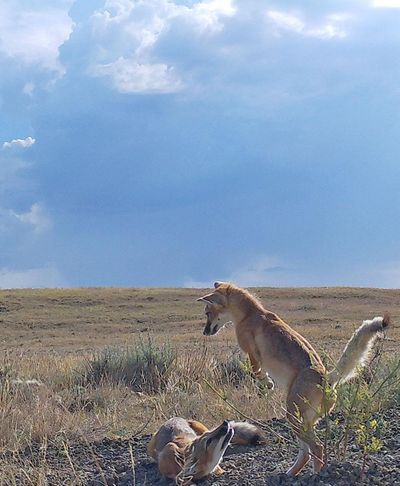Swift foxes, considered locally extinct for decades in Montana, are making a comeback

BILLINGS – Tiny, shy and nocturnal, swift foxes have stealthily invaded pockets of Montana where they haven’t been seen for almost a century.
Or maybe folks just weren’t looking for them and they’ve been surviving in tiny pockets.
“They are definitely around, but unless we ask it’s not on people’s radar,” said Megan O’Reilly, a Montana Fish, Wildlife and Parks wildlife biologist in Billings. “I’m going to guess they’re not as isolated as we thought.”
Ashley Taylor, the FWP wildlife biologist in Harlowton, Montana, echoed O’Reilly’s comment. She’s had confirmed reports in her region since 2012.
“There’s a good chance they’re native and have been here the whole time,” Taylor said.
Last spring, FWP offices in Billings and Glasgow put out a call to the public asking them to report any swift fox sightings.
“We’ve actually been pretty successful,” said Heather Harris, FWP wildlife biologist in Glasgow. “We got lots of calls. Some turned out to be swift foxes, some weren’t.”
The problem is the small foxes can resemble young coyotes, so photos, videos or roadkill foxes are needed for confirmation.
“As we do some education and we start getting more samples, I think we’ll find they’ve been here quite a while,” Taylor said.
Historical loss
Swift foxes were considered locally extinct in Montana in 1969.
Plowing up their native mixed-grass prairie and dousing rangeland fires – along with poisoning campaigns aimed at wolves, coyotes and prairie dogs – combined to wipe out the small foxes from about 60 percent of their native range, which once extended from the Texas panhandle to Canada.
“They are a really subtle indicator of prairie health,” said Kristy Bly, a wildlife biologist for the World Wildlife Fund, who has researched swift foxes. “They are the poster child for intact prairie grasslands.”
In the 1980s, Canada began spending what would be $5 million to breed 940 swift foxes in captivity for release onto the prairies of Saskatchewan and Alberta. The population nearly doubled by 2005 and some migrated into northeastern Montana where they were also trapped and relocated, re-establishing populations that are considered the stronghold for the animal in the state.
A map created by the World Wildlife Fund shows swift fox populations thriving in northeastern Montana, with the second-strongest group living on the Blackfeet Indian Reservation along the Rocky Mountain Front in northwestern Montana.
“The Wyoming population is busting out of its seams,” Bly said.
Yet fox movement over the Wyoming border into southeastern Montana seems fairly spotty.
SE Montana
A 2016 research project found that populations of swift foxes in southeastern Montana were separated from Wyoming groups by about 180 miles, more than three times the length of a long-distance dispersal by swift foxes.
“It is therefore unlikely that any corridor could provide adequate connectivity between the populations, and the reintroduction of swift foxes into the corridor may be required to enhance other conservation strategies,” the study’s authors concluded.
Harris is more optimistic.
“There are more and more observations in southeastern Montana, from Broadus up to Jordan,” she said. “It would be wonderful if we could fill that gap.”
Different state
Southeastern Montana differs quite a bit from preferred swift fox habitat, Bly said. They like low, rolling hills with a short-grass prairie and little sagebrush. “(The area) gets more broken, the grasslands are smaller and there’s more topographical relief,” she said.
Swift foxes do well with prairie dog colonies, as a source of food and also to supply the foxes with their underground dens. The downside is that such colonies also attract coyotes, one of the top predators of swift foxes.
“In the past five years there have been more sightings and camera trap events in southeastern Montana, but they are not staying and they are not reproducing,” Bly said.
“Maybe it’s a lot more suitable than we thought. Maybe it’s a numbers game.”
On the edges
For now, some fairly isolated, small populations of swift foxes are surviving in small pockets of habitat. The animals have been confirmed near Shepherd and Molt, outside of Billings, as well as near Harlowton, north of Martinsdale and Two Dot.
A roadkill swift fox was found as far west as Gallatin County. In southeastern Montana, the foxes have been confirmed in the Miles City area and near Jordan, just south of Fort Peck Reservoir.
“It’s just a really big state,” Bly said. “They can travel a long ways, but can they find other foxes to start a population with?”
Swift foxes are also making a slow, arduous comeback in parts of South Dakota and North Dakota following reintroduction efforts there, populations that could someday interact with Montana and Wyoming populations if connectivity is established.
“Where do the biggest chunks of short grass prairie exist, and can we connect them?” Bly said.
She wonders if another strategically placed reintroduction would help speed things up in southeastern Montana, or if it’s a matter of time before they fill in the map on their own.
“I’m more hopeful about swift foxes than I have been in a long time,” she said.